
3,4-Methylenedioxymethamphetamine (MDMA), commonly known as ecstasy (E) or molly, is a psychoactive drug primarily used for recreational purposes. The desired effects include altered sensations, increased energy, empathy, and pleasure. When taken by mouth, effects begin in 30 to 45 minutes and last 3 to 6 hours.

Empathogens or entactogens are a class of psychoactive drugs that produce experiences of emotional communion, oneness, relatedness, emotional openness—that is, empathy or sympathy—as particularly observed and reported for experiences with 3,4-methylenedioxymethamphetamine (MDMA). This class of drug is distinguished from the classes of hallucinogen or psychedelic, and amphetamine or stimulant. Major members of this class include MDMA, MDA, MDEA, MDOH, MBDB, 6-APB, methylone, mephedrone, GHB, GBL, αMT, and αET, MDAI among others. Most entactogens are phenethylamines and amphetamines, although several, such as αMT and αET, are tryptamines. When referring to MDMA and its counterparts, the term MDxx is often used. Entactogens are sometimes incorrectly referred to as hallucinogens or stimulants, although many entactogens such as ecstasy exhibit psychedelic or stimulant properties as well.
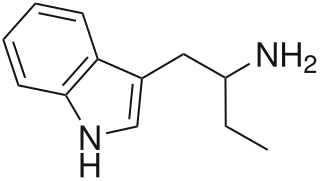
α-Ethyltryptamine, also known as etryptamine, is a psychedelic, stimulant, and entactogenic drug of the tryptamine class. It was originally developed and marketed as an antidepressant under the brand name Monase by Upjohn in the 1960s.
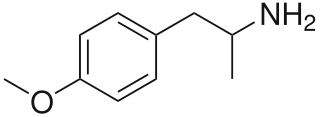
para-Methoxyamphetamine (PMA), also known as 4-methoxyamphetamine (4-MA), is a designer drug of the amphetamine class with serotonergic effects. Unlike other similar drugs of this family, PMA does not produce stimulant, euphoriant, or entactogen effects, and behaves more like an antidepressant in comparison, though it does have some psychedelic properties.

Benzylpiperazine (BZP) is a recreational drug with euphoriant and stimulant properties. The effects produced by BZP are comparable to those produced by amphetamine. Adverse effects have been reported following its use including acute psychosis, renal toxicity and seizures. Deaths from piperazine derivatives are rare, but there has been at least one death apparently due to BZP alone. Its sale is banned in several countries, including Australia, Canada, New Zealand, the United States, the Republic of Ireland, the United Kingdom, Bulgaria, Romania and other parts of Europe.
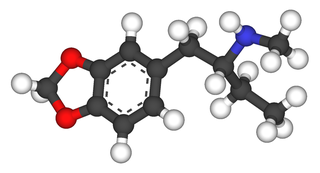
1,3-Benzodioxolyl-N-methylbutanamine (N-methyl-1,3-benzodioxolylbutanamine, MBDB, 3,4-methylenedioxy-N-methyl-α-ethylphenylethylamine) is an entactogen of the phenethylamine chemical class. It is known by the street names Eden and Methyl-J. MBDB is a ring substituted amphetamine and an analogue of MDMA. Like MDMA, it has a methylene dioxy substitution at the 3 and 4 position on the aromatic ring; this is perhaps the most distinctive feature that structurally define analogues of MDMA, in addition to their unique effects, and as a class they are often referred to as "entactogens" to differentiate between typical psychostimulant amphetamines that (as a general rule) are not ring substituted. MBDB differs from MDMA by having an ethyl group instead of a methyl group attached to the alpha carbon; all other parts are identical. Modification at the alpha carbon is uncommon for substituted amphetamines. It has IC50 values of 784 nM against 5-HT, 7825 nM against dopamine, and 1233 nM against norepinephrine. Its metabolism has been described in scientific literature.

Ethcathinone, also known as ethylpropion or ETH-CAT, is a stimulant drug of the phenethylamine, amphetamine, and cathinone chemical classes. It is an active metabolite of the prodrug diethylcathinone and is fully responsible for its effects. Ethcathinone has been identified as an ingredient in both quasi-legal "party pills", and, along with mephedrone, has also been reported as having been sold as "ecstasy" in the Australian city of Cairns.

SR 59230A is a selective antagonist of the beta-3 adrenergic receptor, but was subsequently shown to also act at α1 adrenoceptors at high doses. It has been shown to block the hyperthermia produced by MDMA in animal studies.

MDAI (5,6-methylenedioxy-2-aminoindane) is a drug developed in the 1990s by a team led by David E. Nichols at Purdue University. It acts as a non-neurotoxic and highly selective serotonin releasing agent (SSRA) in vitro and produces entactogen effects in humans.

3-Methoxy-4-methylamphetamine (MMA) is an entactogen and psychedelic drug of the phenethylamine and amphetamine classes. It was first synthesized in 1970 and was encountered as a street drug in Italy in the same decade. MMA was largely forgotten until being reassayed by David E. Nichols as a non-neurotoxic MDMA analogue in 1991, and has subsequently been sold as a designer drug on the internet since the late 2000s (decade).
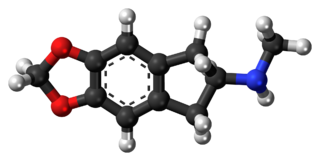
5,6-Methylenedioxy-N-methyl-2-aminoindane (MDMAI), is a drug developed in the 1990s by a team led by David E. Nichols at Purdue University. It acts as a non-neurotoxic and highly selective serotonin releasing agent (SSRA) in animals and a putative entactogen in humans.

Nantenine is an alkaloid found in the plant Nandina domestica as well as some Corydalis species. It is an antagonist of both the α1-adrenergic receptor and the serotonin 5-HT2A receptor, and blocks both the behavioral and physiological effects of MDMA in animals.

α-Methyldopamine (α-Me-DA), also known as 3,4-dihydroxyamphetamine, is a research chemical of the catecholamine and amphetamine chemical classes. Its bis-glutathionyl metabolite is slightly neurotoxic when directly injected into the brain's ventricles.

4-Chlorophenylisobutylamine, also known as 4-chloro-α-ethylphenethylamine, is an entactogen and stimulant drug of the phenethylamine class. It is an analogue of para-chloroamphetamine (PCA) where the alpha position methyl has been replaced with an ethyl group.

Difluoromethylenedioxyamphetamine (DiFMDA) is a substituted derivative of 3,4-methylenedioxyamphetamine (MDA), which was developed by Daniel Trachsel and coworkers, along with the corresponding fluorinated derivatives of MDMA, MDEA, BDB and MBDB, with the aim of finding a non-neurotoxic drug able to be used as a less harmful substitute for entactogenic drugs such as MDMA. Since a major route of the normal metabolism of these compounds is scission of the methylenedioxy ring, producing neurotoxic metabolites such as alpha-methyldopamine, it was hoped that the difluoromethylenedioxy bioisostere would show increased metabolic stability and less toxicity.

1-Methylamino-1-(3,4-methylenedioxyphenyl)propane or M-ALPHA is an empathogen, reported by Alexander Shulgin in his book PIHKAL as a positional isomer of MDMA, and subsequently found being sold as a designer drug in the UK in 2010, and reported to the EMCDDA new drug monitoring service. It was described by Alexander Shulgin as similar in action to its demethylated homologue, ALPHA, but with roughly twice the duration and twice the potency.

UWA-101 is a phenethylamine derivative invented by Dr Matthew Piggott at the University of Western Australia, and researched as a potential treatment for Parkinson's disease. Its chemical structure is very similar to that of the illegal drug MDMA, the only difference being the replacement of the α-methyl group with an α-cyclopropyl group. MDMA has been found in animal studies and reported in unauthorised human self-experiments to be effective in the short-term relief of side-effects of Parkinson's disease therapy, most notably levodopa-induced dyskinesia. However the illegal status of MDMA and concerns about its potential for recreational use, neurotoxicity and potentially dangerous side effects mean that it is unlikely to be investigated for medical use in this application, and so alternative analogues were investigated.
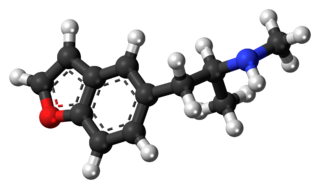
5-MAPB is an entactogenic designer drug similar to MDMA in its structure and effects.

6-Chloro-MDMA is a derivative of the amphetamine drug MDMA, which has been identified both in seized "ecstasy" tablets and in urine samples from drug users. It is thought most likely to be an impurity from synthesis and its pharmacological properties have not been established, however it has been banned in several countries.

N-t-BOC-MDMA is a chemical compound which can be both a synthetic precursor to, or a prodrug of the empathogenic drug MDMA. It was first identified in Australia in 2015 as a seizure by customs, and has subsequently been found in China, Holland and other European countries. Originally it was thought to be intended as a non-illegal form of MDMA which could be easily converted into the prohibited final product after importation, however one seizure by police found N-t-BOC-MDMA in the process of being pressed into pills, and experiments with simulated gastric fluid confirmed that it can be broken down to MDMA by human stomach acid. Similar N-protected compounds such as N-t-BOC-methamphetamine, N-p-tosyl-methamphetamine, N-t-BOC-ketamine, N-t-BOC-norketamine and N-methoxycarbonyl-MDA have also been encountered by law enforcement.




















